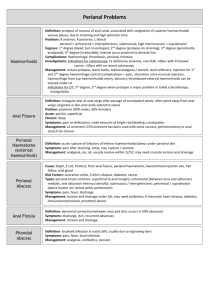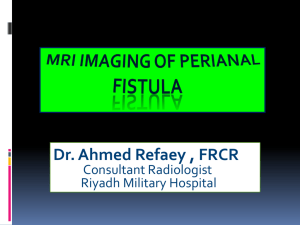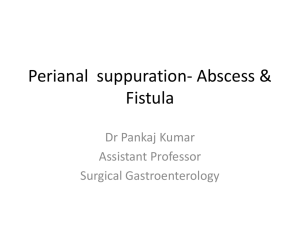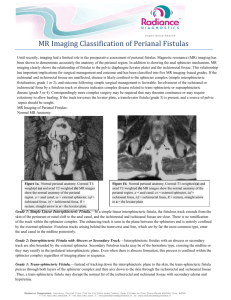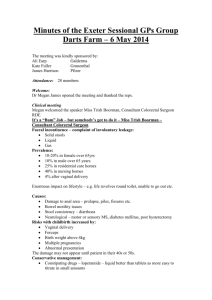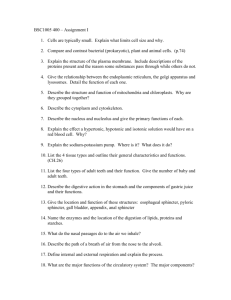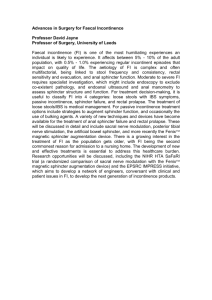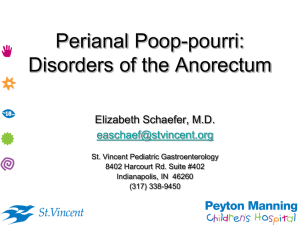Perianal abscess & pilonidal disease
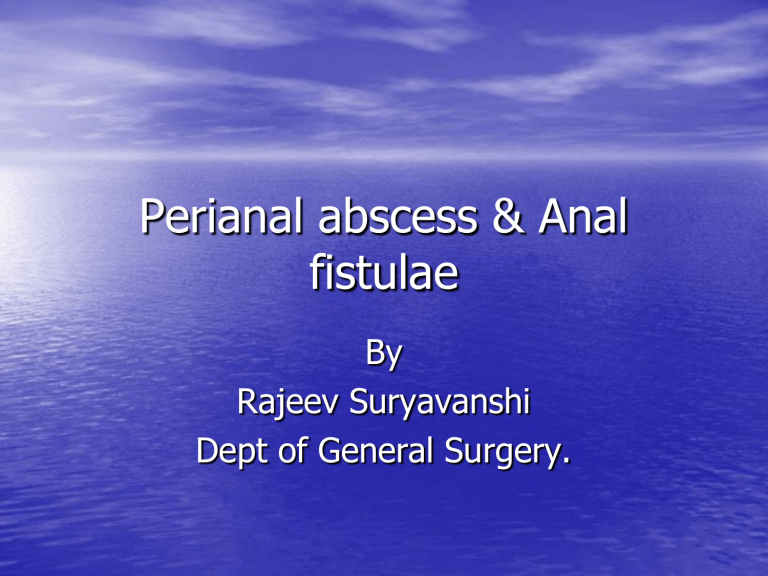
Perianal abscess & Anal fistulae
By
Rajeev Suryavanshi
Dept of General Surgery.
Perianal abscess
Definition -
• Infection of the soft tissue surrounding the anal canal, with formation of discrete abscess cavity.
• Often cavity is associated with fistulous tract.
Anorectal anatomy
• Rectum develops from hind gut at 6 weeks
• Anal canal formed at 8 weeks – ectoderm.
• Dentate line transition from endo to ecto.
• Rectum has inner – circular.
outer – longitudinal.
• Anal canal – 4cm, pelvic diaphragm to anal verge.
Anatomy
External Sphincter-
- U shaped , continuation of levator ani
- deep segment is continuous with puborectalis muscle and forms anorectal ring felt on DRE.
- striated muscle
- voluntary control
- 3 components - sub mucous, superficial and deep.
Anatomy-
• Internal sphincter-
- smooth muscle
- autonomic control
- extension of circular muscles of rectum.
- contracted at rest.
Anatomy
• 4-8 anal glands drained by respective crypts, at dentate line.
• Gland body lies in intersphincteric plane.
• Anal gland function is lubrication.
• Columns of Morgagni
8-14 long mucosal fold.
Pathophysiology
• Infection starts in crypto glandular epithelium lining the anal canal.
• Internal anal sphincter a barrier to infection passing from gut to deep perirectal tissue.
• Duct of Anal gland penetrate internal sphincter into intersphincteric space.
• Once infection sets in intersphincteric space it can spread further.
Pathophysiology
Glandular secretion stasis
Infection & suppuration
Anal crypts obstruction abscess formation
Frequency
• Common in 3 rd and 4 th decade of life
• Male > female (2:1)
• 30% present with previous episodes.
• Increase incidence during summer and spring.
• Common in infants , poorly understood mechanism , fairly benign and majority settle with simple drainage.
Etiology
• Abscess initially forms in the intersphincteric space and spreads along adjacent potential spaces.
• Common organisms-
* E.Coli
* Enterococcus species
* Bacteroides species.
Etiology
Less common causes -
• Crohn’s Disease.
• Cancer.
• Tuberculosis.
• Trauma.
• Leukemia.
• Lymphoma.
Clinical features
Symptoms-
• Pain Perianal movement ↑ pressure ↑
• Pruritis
• Generally unwell.
• Fever
• Chill and rigor.
Signs-
• Swelling
• Cellulitis
• induration
• Fluctuation
• Subcutaneous mass, near Perianal orifice.
• DRE- fluctuation at times in ischorectal.
Classification of Anorectal abscesses
• Perianal 60%
• Ischiorectal 20%
• Intersphincteric 5%
• Supralevator 4%
• Submucosal 1%
Classification
• Perianal – pus underneath skin of anal canal, do not traverse external sphincter.
• Ischiorectal – suppuration traversing external sphincter into Ischiorectal space.
• Intersphincteric – suppuration between external and internal sphincter.
• Horse shoe abscess - uncommon circumferential infiltration of pus with in intersphincteric space.
Investigation & Imaging
• No specific test required
• Patients with diabetes , immunosuppresed will need lab evaluation.
• Imaging – role in only deep seated,
Supralevator or intersphincteric abscesses.
CT Scan , MRI or Anal ultrasonography.
Management
• Mainly surgical
• Antibiotics in diabetics & immunocompromised individuals.
• Early drainage is indicated as delay can cause-
* prolong infection
* tissue destruction ↑
* chances of sphincter dysfunction ↑
* Promote fistula formation.
Management
1.
Perianal abscess
- superficial ones can be drained in office under L.A
• Incision
• Pus culture & sensitivity
• Packing with iodophor gauge.
• Laxative & Sitz bath.
• Review & follow up 2-3 weeks to see for healing & fistula formation.
Management
• Organism culture is important.
• Abscess with intestinal organisms have a 40% chance of forming fistula.
• Cultures growing Staphylococcus species –
Perianal skin infection and have no risk of subsequent fistula formation.
2. Ischiorectal abscess -
• GA
• Cruciate incision over max swelling.
Management
• Pus drained and cultured
• Disrupt loculi
• Drain placed.
3.
Intersphincteric abscess
-
• Transverse incision in anal canal below the dentate line, posteriorly.
• Abscess opened, leave drain, prevents premature closure.
Management
4.
Supralevator abscess -
• Location & etiology determines its drainage technique.
• Evaluation with CT Scan & MRI .
• Abdominal pathology –deal with cause
• If extension of Ischiorectal –drainage through the space indicated.
• Anterior Supralevator are superficial and more common in females.- transanal or transvaginal approach can be used.
Anal fistula- “Fistula-in-ano”
Definition
-
• Hollow tract, lined with granulation tissue connecting a primary opening inside the anal canal to a secondary opening in the
Perianal skin.
• Treatment of fistula-in-ano can be challenging.
Fistula-in-ano
• Magnitude of problem-
Prevalence rate - 8.6 / 100,000 population.
• Male : Female = 2 : 1
• Mean age = 38 Years.
Etiology
* Following Anorectal abscess.
* Other causes
- Sec. to trauma
- Crohn’s disease
- Anal fissures
- Carcinoma
- Radiation therapy
- Tuberculosis, Actinomycosis.
Pathophysiology
Fistula formation Anal gland infection
Drainage self/ surgery Perianal abscess
Clinical presentation
• History – Recurrent Swelling, Discharge,
Pain and Surgery for an Abscess.
• Symptoms –
- Perianal discharge - Pain
- Swelling - Bleeding
- External opening
Clinical presentation
• Past medical history-
* Inflammatory bowel disease.
* Diverticulitis
* Previous pelvic radiation
* Tuberculosis
* Steroids therapy
* HIV infection
Clinical presentations
• Physical examination -
* Look at entire perineum,
* An open sinus or elevation of granulation tissue.
* Discharge may be seen.
* DRE- fibrous cord, or cord beneath the skin.
* Voluntary squeeze pressures & sphincter tone should be assessed.
Goodsall rule – Perianal fistula
• Transverse line drawn across the anal verge
• Anterior external opening associated with straight tract to anal canal or rectum.
• Posterior ext. opening follows curved tract, entering posterior midline.
• Exception 3cm
Park Classification system-
A.
Intersphincteric
B.
Transsphincteric
C.
Suprasphincteric
D.
Extrasphincteric
Fistula-in-ano
• Fistula with probe
Fistula-in-ano
A. Intersphincteric -
• Via internal sphincter to intersphincteric space then to perineum.
• 70%
B. Transsphincteric -
• Via internal and external sphincter into
Ischiorectal fossa and then to perineum.
• 25%
Fistula-in-ano
• Transsphincteric fistula.
Fistula-in-ano
C. Suprasphincteric –
• Via intersphincteric space superiorly to above puborectalis muscle into
Ischiorectal fossa then perineum.
• 5%
D. Extrasphincteric -
• From Perianal skin through levator ani muscles to the rectal wall completely outside sphincter mechanism.
• <1%
Imaging Studies
• Not indicated for routine evaluation
• Performed when external opening is difficult to identify, recurrent or multiple fistulae.
1.
Fistulography -
- involves injection of contrast via the opening and taking images in different planes.
- 15- 48% accuracy.
Imaging studies
2. Endo Anorectal Ultrasonography -
- Transducer 7-10 MHz.
- Installation of H2O2 can help location of internal opening .
- not widely used.
3. MRI -
- Study of choice
- 80-90% concordance with oper.finding.
- good for primary course and sec extensions.
Imaging
4.
CT Scan
–
- Good for perirectal inflammation disease, delineating fluid pockets.
- Needs oral and rectal contrast.
- poor delineation of muscular anatomy.
5.
Barium enema / Small bowel series
-
- Useful in multiple fistulae or recurrent disease, also to rule out IBD.
fistula imaging
• MRI showing intersphincteric fistula anteriorly
• Prm-puborectalis muscle.
Other investigations
• Anal Manometry-
Pressure evaluation of sphincter mechanism help in some cases -
- Decreased tone in preop evaluation
- previous fistulectomy
- obstetrical trauma
- high transsphincteric or suprasphincteric fistula
- very elderly patient.
If decreased, avoid - surgical division of any portion of sphincter.
Diagnostic procedures
A. E U A-
• Examination of perineum, DRE, anoscopy.
• To look for internal opening techniques-
- Inject - H2O2, Milk, Dilute methylene blue
- Traction on external opening may help
- Probing gently can help.
B. Proctosigmodoscopy / Colonoscopy-
• Rigid sigmoidoscopy to rule rectal disease.
Management
1. Fistulotomy / Fistulectomy -
- laying open technique is useful in 85-95% of primary fistulae.
- overlying skin, subcutaneous tissue, internal sphincter divided with electrocautry, curette tract to remove granulation tissue.
- complete fistulectomy creates bigger wound with no advantage in minimizing recurrence.
- perform biopsy of firm or suggestive tissue.
Management
2. Seton Placement stage procedure-
Useful in –
–
- Alone, in combination with fistulectomy or as a
• Complex fistulae
• Recurrent fistulae after fistulectomy
• Anterior fistulae in females
• Poor preop sphincter pressure.
• Immunosuppresed patients.
Seton placement-
• Seton defines sphincter muscles
• Promotes - Drainage
- Fibrosis.
• Material used-
- Silk suture
- Silastic vessel markers
- Rubber bands
Seton
1.
Single stage (cutting)
• Passing seton through tract and tightened down with separate silk tie.
• Fibrosis above sphincter muscles seen as it cuts the muscles.
• Tightened in office over weeks
2. Two Stage (draining / fibrosis)
• Pass seton through deep portion of external sphincter.
• Seton left loose here.
• When superficial wound is healed , seton bound muscle is divided.
• Studies support 2 stage procedure using 0-nylon.
3.Mucosal Advancement Flap -
• In chronic high fistula , indication same as seton.
• Total fistulectomy , removal of primary and secondary tract with internal opening
• Rectal mucomuscular flap is raised .
• Internal muscle defect is closed with absorbable suture and flap is sewn down over internal opening.
• Single stage procedure
• Poor success in Acute infection and Crohn’s.
Follow up
• Sitz bath
• Analgesia
• Stool bulk agents (bran)
• Frequent office visits to ensure healing.
• Healing in 6 weeks.
Complications
Early-
• Urinary retention
• Bleeding
• Fecal impaction
• Thrombosed hemorrhoids.
Delayed -
• Recurrence
• Incontinence stool)
• Anal stenosis
• Delayed wound healing.
Outcome & Prognosis
Following Rate of
Recurrence
0 -18% Standard
Fistulotomy
Seton 0 – 17%
Incontinence of stool
3 -7 %
0 -17 %
Mucosal advancement flap
1- 10% 6 – 8%
Newer Developments
1.
Biotechnical advances are producing many new tissue adhesives.
- some reports suggest 60% success with
1 year follow-up ,using fibrin glue in treatment of fistula-in-ano.
- less invasive & ↓ postop morbidity.
Newer developments
• Recurrent fistulous disease to rectum and perineum with Anorectal sepsis – indication for surgery
• Recent reports suggest 50-60% response rate with infiximab - the monoclonal antibody to TNFα for Perianal fistulae.
